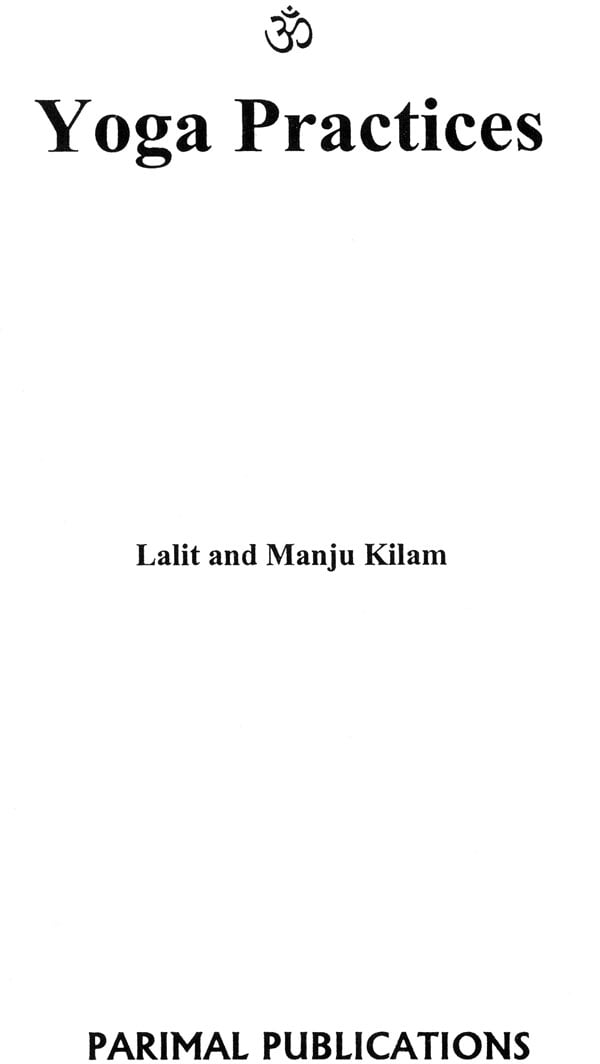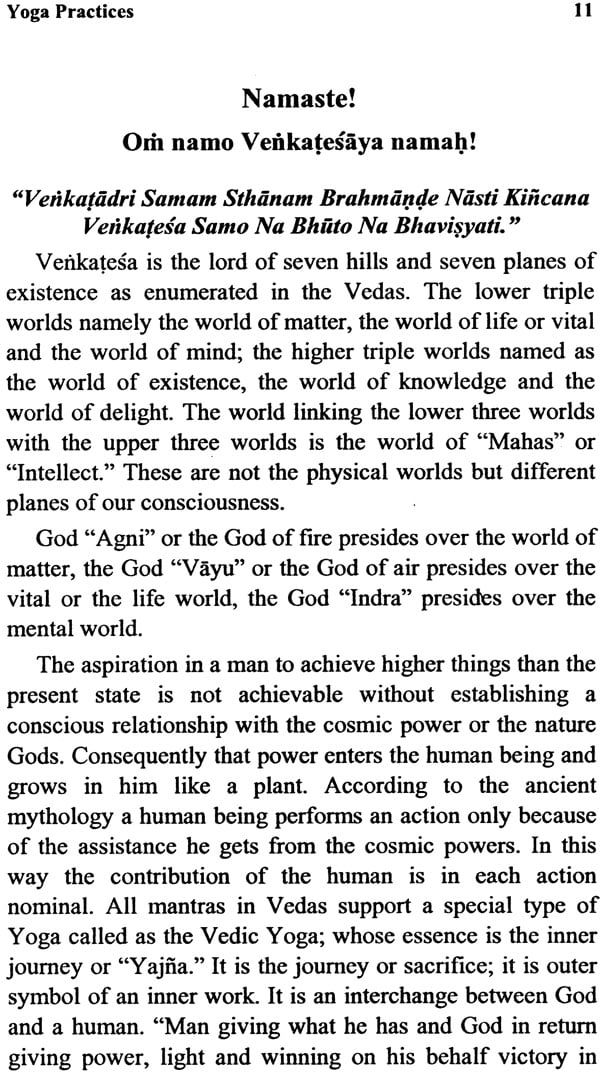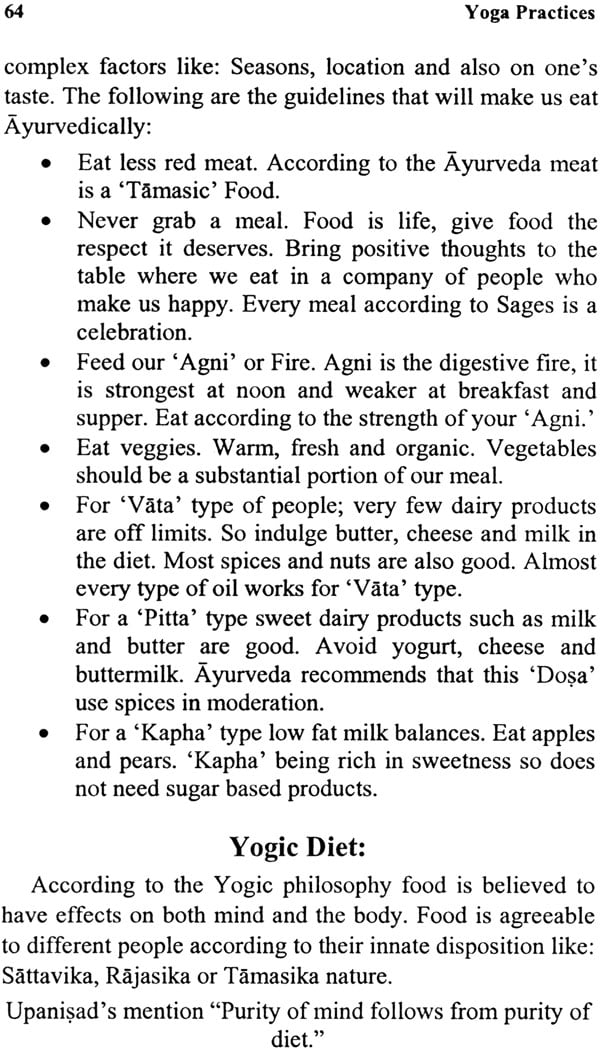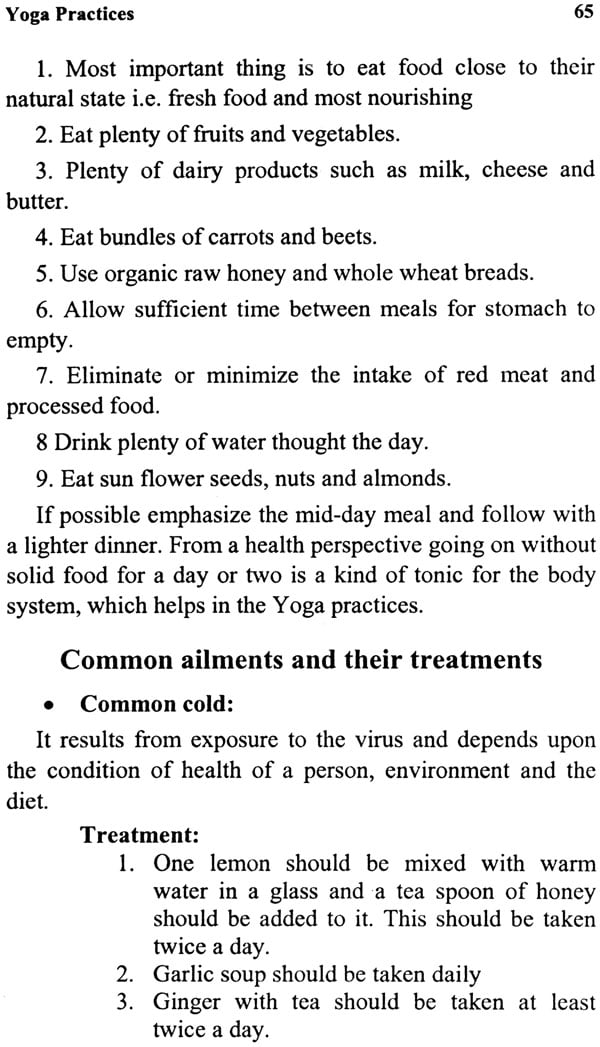
Yoga Practices
Book Specification
| Item Code: | NAE852 |
| Author: | Lalit Kilam and Manju Kilam |
| Publisher: | Parimal Publication Pvt. Ltd. |
| Language: | English |
| Edition: | 2009 |
| ISBN: | 9788171103454 |
| Pages: | 72 (Throughout B/W Illustrations) |
| Cover: | Paperback |
| Other Details | 8.5 inch X 5.5 inc |
| Weight | 100 gm |
Book Description

Yoga Practices is piece of work which elaborates on well selected illustrations for maintaining physical, mental and spiritual well being. It contains information and instruction regarding the most aspects of Yoga practices which are applicable to a working and a non working individual. These yoga practices and the instructions mentioned therein, makes one capable of doing yoga without much discomforts.
Lalit Kilam was educated in an Ayurvedic school in the mountainous region of the Himalayas. He completed his engineering degree from the University which is located on the bank of river Odra in Europe. At present he is interconnecting masses by providing High Speed internet and WBBI to the customers of Saskatchewan. According to Lalit, Yoga and meditation are the essence of existence called Spirituality, which exists in each one of us. The more it develop the better person you are.
Manju Kilam has a Ph.D. degree from one of the prestigious Universities in a province where the river Ganges flows. She has taught in India and at various colleges in Canada. At present she teaches in the school of Business Administration. Manju is a sincere believer in the teachings of Yoga and Spiritual growth as an approach towards betterment of human life.
If you have reached the conclusion that Yoga is perfect for you at this point in your life, you probably know that there is the existence of God. The important thing is for people to first get started; it really is not important what style you do but that you simply practice the yoga.
“In life there will be always many paths to follow; I hope you always choose the right one..: if you give a part of yourself to life, the part you receive back will be so much greater. Never regret the past, but learn by it. Never loose sight of your dreams; a person who can dream will always have hope. Believe in yourself; if you do, everyone else will, you have the ability to accomplish anything, but never do it at someone else’s expense. If you can go through life loving others, you will have achieved the greatest success of all.
The word Yoga is a Sanskrit word which means to 1-Harmonize or Unite.” The science of Yoga is vast and has teen divided into different branches which are based on the experiences and observations. In the ancient times the Rsis and Seers of truth with their keen observations discovered finer forces of nature and also uncovered the finer forces that govern our physical, mental and spiritual being.
Methods by which these Scientific Truths were applied in daily life of an individual to further his spiritual development were called by the Yoga; methods of realizing the truth and attaining the highest wisdom. Yogi is one who through various practices reaches the highest ideal of spiritua1 life. Spirituality does not depend on book know1edge, nor on the intellectual understanding but on the spiritual practices of yoga.
Yoga unites the body, mind and the soul. It is a system of healthy, happy and peaceful living. Yoga practices also increase the life span of a human being. It makes us more familiar with our entire body. Yoga practice has its roots in the ancient healing methods where simplicity was the answer to most dreadful and serious ailments. It is the road to express the beauty, nobility and true divinity of human spirit.
Perfections in the Asanas does not come in a day;1t requires years of strenuous efforts, therefore one should not give up one’s yoga practices even if initially one does not experience much success. The yoga practices should be continued with renewed and with much vigor. Just a little practice of yoga will bestows upon the student a great deal of inner strength. While practicing the yoga Asanas, the mind should not think of the daily routine or of the engagements or any other external object. One must withdraw the mind from all such thoughts. As suggested by adepts while doing the äsanas, one should concentrate the mind on the relevant parts of the body according to the nature of the Asanas practiced.
The difference between Yoga and other forms of exercises is that exercises is more superficial for example building muscles etc. of the body where as yoga provides a comprehensive system of exercise that strengthens, stretches and helps to align and improve the health of the entire body. In Yogic practices there is harmonious development of all the muscles of the body, internal organs, nerves and the frame. In yoga practices there are no rapid movements, hence there is no waste of energy. In yoga exercises movements are gentle and rhythmic. Some yoga äsanas involve forward and backward motions others help the movements of the spine while as others help clean lungs, throat etc. Thereby the body as a whole is develop and becomes flexible. Regularity is the most important - factor to derive the full benefits of Yogasanas.
| Introduction To Yoga | 9 |
| Namaste | 11 |
| Yoga and the nature Gods | 13 |
| Surya - the God of Light | 14 |
| Agni - the God of Fire | 15 |
| Vayu - the God of Wind | 15 |
| Prthvi - the God of Earth | 15 |
| Jala - the God of Water | 16 |
| Akasa - The God of Sky | 17 |
| Yoga Practices | 18 |
| Yoga-sutras of Maharsi Patanjali | 20 |
| Different schools of Yoga | 21 |
| The main Yogas may be discerned as follows: | 21 |
| The steps of the Astangayoga | 22 |
| Social Discipline - Yamas | 22 |
| Individual Discipline - Niyamas | 22 |
| Asanas (postures) | 22 |
| Pranayama (breath control) | 22 |
| Breathing is important for two basic reasons | 23 |
| Pranayama (sense withdrawal) | 23 |
| Dharana (concentration) | 23 |
| Samadhi (Super Consciousness) | 23 |
| Dhyana (Meditation) | 24 |
| Cakras | 25 |
| The Seven main Cakras | 26 |
| Prana of energy centers | 26 |
| Rules useful for Yoga practices | 27 |
| Asanas in Daily Life | 28 |
| Yoga Asanas | 28 |
| Surya Namaskara | 29 |
| Prayer to the Sun God, Om! | 30 |
| Step 1 Process: | 30 |
| Om Ravye namah: | 31 |
| Step 2 Process | 31 |
| Om Suryaya namah: | 32 |
| Step 3 Process | 32 |
| Step 4 process | 33 |
| Step 5 Process | 33 |
| Step 6 Process | 34 |
| Step 7 Process | 34 |
| Step 8 Process | 35 |
| Step 9 Process | 35 |
| Step 10 Process | 36 |
| Step 11 Process | 36 |
| Step 12 Process | 37 |
| Padmasana | 39 |
| Process | 39 |
| Benefits | 40 |
| Siddhasana | 40 |
| Process | 41 |
| Benefits | 41 |
| Pascimottanasana | 42 |
| Process | 42 |
| Benefits | 43 |
| Bhujangasana | 43 |
| Process | 43 |
| Benefits | 44 |
| Sarvangasana | 44 |
| Process | 45 |
| Benefits | 45 |
| Halasana | 46 |
| Process | 46 |
| Benefits | 47 |
| Garudasana | 47 |
| Process | 48 |
| Benefits | 48 |
| Ardha Matsyendrasana | 48 |
| process | 49 |
| Benefits | 50 |
| Savasana | 50 |
| Process | 50 |
| Benefits | 51 |
| Parvana Muktasana | 51 |
| Process | 51 |
| Benefits | 52 |
| Ustrasana | 52 |
| Process | 52 |
| Benefits | 53 |
| Gomukhasana | 53 |
| Process | 53 |
| Benefits | 54 |
| Utkatasana | 54 |
| Process | 54 |
| Benefits | 55 |
| Mandukasana | 55 |
| Process | 55 |
| Benefits | 56 |
| Markatasana | 56 |
| Process | 56 |
| Benefits | 56 |
| Tadasana | 57 |
| Process | 57 |
| Benefits | 58 |
| Trikonasana | 58 |
| Process | 58 |
| Variation 1 | 60 |
| Process | 60 |
| Benefits | 61 |
| Yoga and Ayurveda | 62 |
| Ayurvedic Diet for Well Being | 63 |
| Yogix Deit: | 64 |
| Common ailments and their treatments | 65 |
| Names of the Asanas (postures): | 67 |
| Vedic Yoga center | 69 |
| Glossary | 71 |









